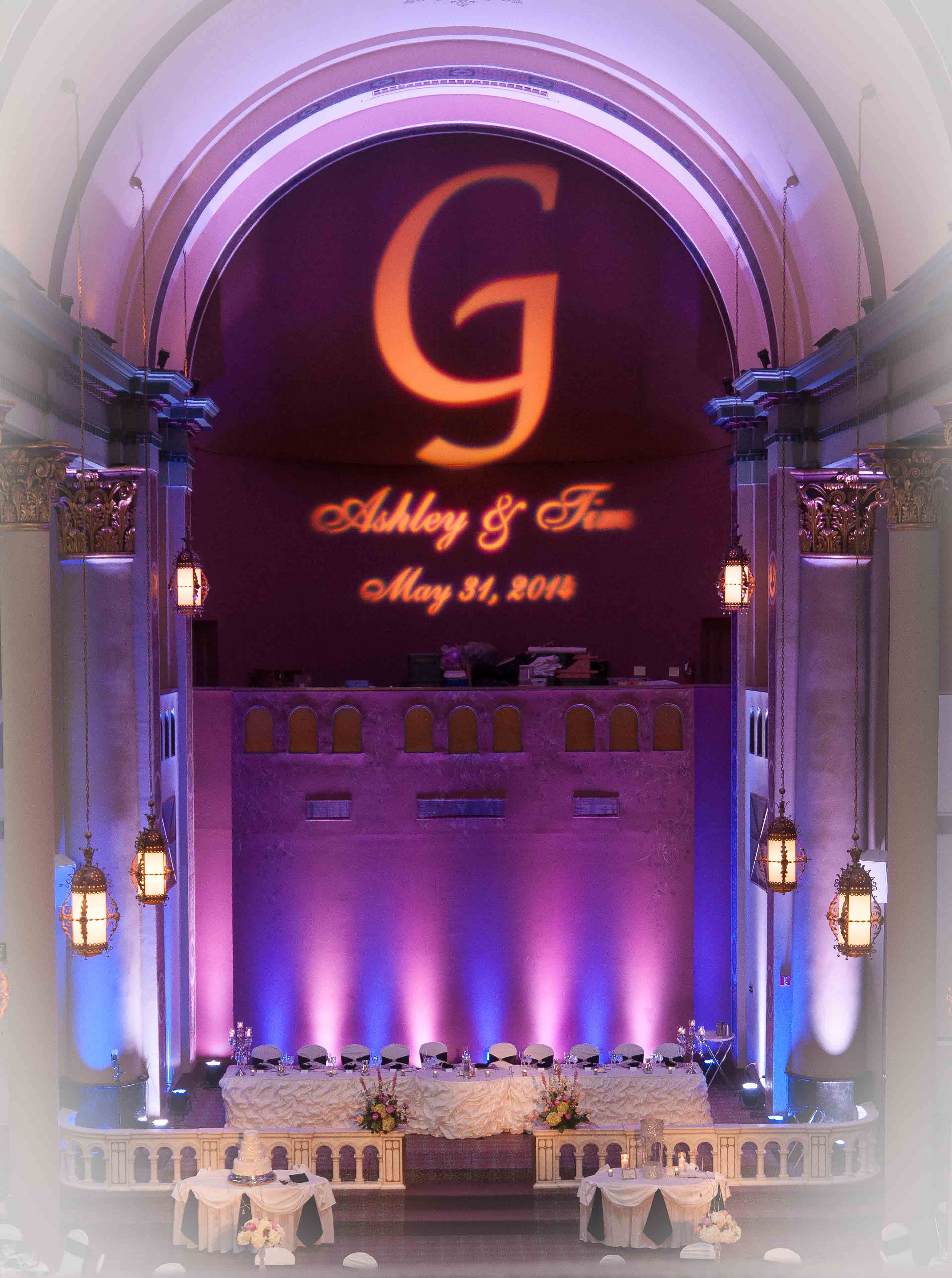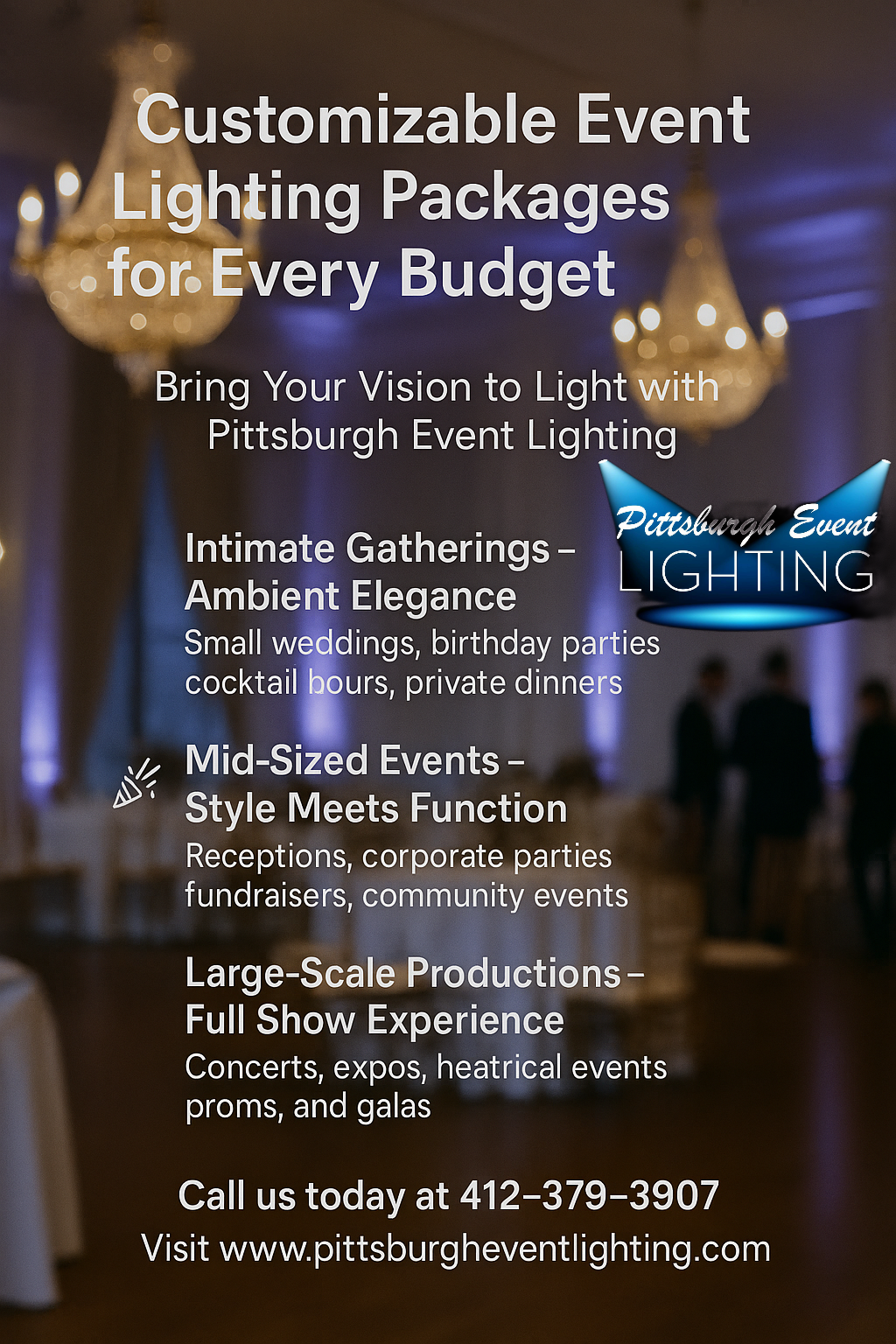So you don’t know anything about lighting, but you know that you want it? Let us guide you through the basics of event lighting. Many of these techniques can be applied and layered to create a complete lighting design. However not all of these techniques are appropriate for every venue or event.
UPLIGHTING
Uplighting is often the first step in changing the look of your venue. It can highlight and enhance existing architectural features. It can add warmth and color to a room that has an otherwise drab atmosphere. And it is the easiest way to carry your color scheme throughout the entire room without costly décor or fabric. Uplighting starts with a basic fixture that sits on the floor and has a colored gel applied to create color. The next step is to use color changing LED fixtures for your uplights. The main benefits of LED uplighting vs static are color mixing options, the ability to change color during the event, and greatly reduced power consumption. This is perfect for older venues where limited power is an issue. We also offer battery operated LED fixtures which have the added ability of running without any cables. This is great for lighting underneath tables or in rooms where you want a very clean look.
PIN SPOTS
A pin spot is a fixture with a tight, intense beam, most often used to accent centerpieces. Pin spotting brings out the color of flowers, and provides the flexibility to reduce the “house” lighting and increase the impact of your table design. Pin spots work best in rooms with high ceilings or overhead lighting positions like balconies or coves. They are not as effective when used from the sides of a room. Make sure your flowers don’t disappear into the evening. Taking the time to pin spot floral centerpieces is well worth the money, just ask a florist.
GOBOS
A gobo is an accessory that creates an image with light and shadow. They come in a wide variety of media. Here are just two of the possibilities.
CUSTOM GOBOS
Everyone wants to see their name in light! Using a custom image can be the easiest way to brand your event.
GOBOS FOR TEXTURE
Using stock gobos to wash a wall or floor adds a large range of textures with color. Use paisley to dress up the aisle at your wedding or a simple breakup to add textural dimension to your dance floor or tables.
STAGE LIGHTING
If your event includes entertainment, presentations, or speeches you should consider stage lighting. A small number of fixtures can highlight a stage or a designated space, and draw your guest’s attention to a speaker or entertainment.
LED FIXTURES
The main benefits of LED lighting are color mixing capability and greatly reduced power consumption. Color mixing means you can change or fine-tune colors on the spot, as well as potentially change colors during your event. Low power consumption means that several dozen fixtures can run on a single circuit. This is perfect for venues where limited power is an issue.
Battery operated LED fixtures offer the flexibility of setup without cables. This is great for lighting underneath tables or in rooms where you want a very clean look.
MOVING LIGHTS
Moving Lights provide an added level of excitement to any event by bringing animation, color and texture together in one fixture. They can be static (non-moving) at the beginning of your event, but as the tempo of the evening picks up the lights can transform to bring the room to life. They provide the versatility to change color and patterns as your event changes. Custom gobos in moving lights can have a much greater impact than in static fixtures.
HAZE
Theatrical haze greatly increases the impact of any lighting effect. The viewer sees the actual beam of light along with the effect on surfaces that the light hits. The use of haze is strictly regulated in most venues, and can result in extra venue expenses including the cost of a detail officer from the local fire department. Ask your venue representative about using haze for your event. The investment you make in adding haze will double the impact of your lighting. These are some of the techniques that make up a complex lighting design. With a basic knowledge of the terms you can work with your designer to create a system that fits your event and budget.
POWER
When planning any event it’s important to calculate the total amount of power required. Lighting, sound, and catering needs are common, but video projection, décor, and/or games may also be in the room, and could require power as well. Good advance planning can reduce the chances of a power failure, or of the late addition of a generator that wasn’t in your budget. One of the factors that can limit the lighting options for a given venue is available power. Lighting can consume a lot. A common floor lamp at home might use a 60-watt lamp, which translates into ½-amp. Up to 40 of those lamps will fit on one 20-amp circuit breaker. Many of the lights we use for events start in the 600-watt range, or 5-amps per light. Now we are down to just 4 lamps per 20-amp circuit breaker. A simple stage wash for a band might use 12 or more lights at 600-watts each, for a total of 60 amps. You can see how lighting can use up a lot of power quickly, even for a small event.
A venue representative may mention the number of outlets in a room. Be careful not to confuse outlets with circuits. A large number of outlets could be wired to a single circuit, particularly in older buildings. A venue electrician or maintenance technician can often tell you how many circuits are available for your event. If not, it’s best to bring in your lighting vendor for an advance visit. Another option for power is to connect directly, or “tie in” to an electrical panel, and bring in portable equipment for your power needs. This can be practical, but may require bringing in a licensed electrician to make the connection
Generators are another option, and come in a variety of sizes and types. They are commonly used for outdoor or tented events, but can also be used to supply power indoors. Plan ahead, know your needs, and don’t hesitate to consult a specialist when you have questions about power.
SCHEDULE AND LOGISTICS
Now that we have talked about design, let’s talk about execution. Site access and timeframe can make all the difference in your lighting. In terms of access are there stairs, tight hallways, or crowded rooms your vendors may have to negotiate? The size of an elevator can determine which equipment we can or cannot use in the space. These things are often addressed at a site inspection, where we can determine which types of gear are practical for a particular room. When it comes to time, access to a room before an event may have a large influence on the lighting design. If we only have access to a room 2 hours before the event, we will not be able to accomplish as much as if we had 8 hours. Sometimes we can address this challenge by adding more crew to get the job done, but some designs take a certain amount of time no matter how many crew members you have. Before booking a venue, make sure to find out how much time before the start of the event we all have to setup, as this will determine design and crew size.
One of the last things we need to accomplish before the load in is complete, is to store the empty cases and install equipment. In an ideal world that would be someplace on site. We can arrange for either the truck to stay on site or return to pick up empties, but this will add additional expense. We prefer to store cases at the venue whenever possible. This is also something that we can usually arrange at the site inspection.










